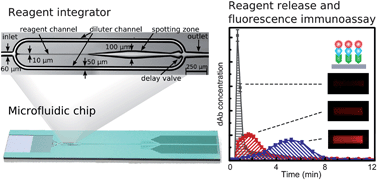Controlled release of reagents in capillary-driven microfluidics using reagent integrators
Abstract
The integration and release of reagents in microfluidics as used for point-of-care testing is essential for an easy and accurate operation of these promising diagnostic devices. Here, we present microfluidic functional structures, which we call reagent integrators (RIs), for integrating and releasing small amounts of dried reagents (ng quantities and less) into microlitres of sample in a capillary-driven microfluidic chip. Typically, a RI is less than 1 mm2 in area and has an inlet splitting into a central reagent channel, in which reagents can be loaded using an inkjet spotter, and two diluter channels. During filling of the microfluidic chip, spotted reagents reconstitute and exit the RI with a dilution factor that relates to the relative hydraulic resistance of the channels forming the RI. We exemplify the working principle of RIs by (i) distributing ∼100 pg of horseradish peroxidase (HRP) in different volume fractions of a 1 μL solution containing a fluorogenic substrate for HRP and (ii) performing an immunoassay for C-reactive


 Please wait while we load your content...
Please wait while we load your content...